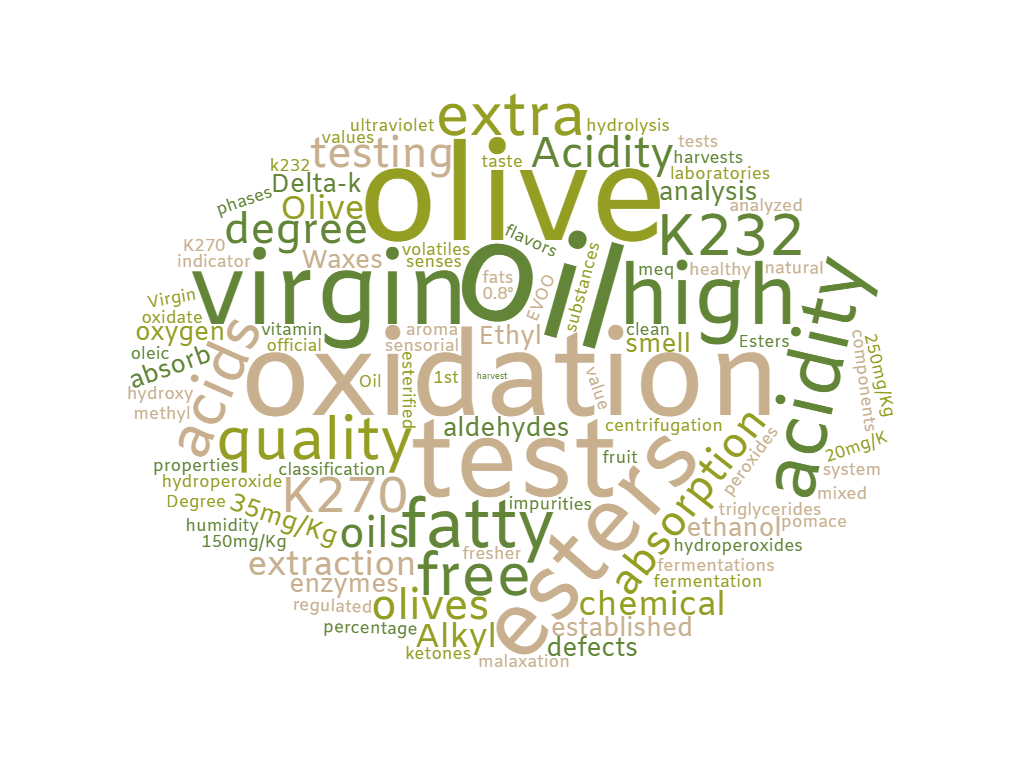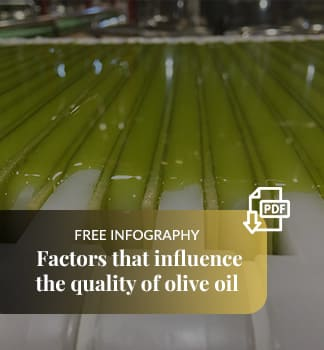In this post we are going to look at the method and procedures to guarantee the authenticity and quality of extra virgin olive oil: testing.
The International Olive Council (IOC) establishes the regulations for olive oil testing with a two method system: a sensorial analysis and a chemical test.
While the sensorial analysis is performed by a qualified testing panel formed by trained Olive Oil Sommeliers that look into the organoleptic senses in olive oil, mainly smell and flavour, chemical tests are done in the laboratories where olive oil is analyzed to look for its chemical compositions.
In our discussion of the physicochemical parameters, we will focus on those that are legally required for the classification of virgin olive oil.
PHYSICO-CHEMICAL PARAMETERS
Acidity
This test shows the quantity or percentage of free fatty acids in an oil, expressed in oleic acid (%).
Fat that is biologically synthesized is neutral, i.e. the oil in a healthy olive that is still on the tree has 0% free acidity.
We start from the assumption that in the oil of an unpicked olive, nearly 100% of the fatty acids are still "united", esterified, primarily as triglycerides. As the olive ripens on the tree, the action of certain enzymes can cause these unions to break, causing esters, which bring out a slight presence of free fatty acids, which means there will be a slight increase in acidity.
When the olives are milled, all the oil is expelled from the vacuoles or vessels along with the vegetable water as well as the enzymes, which inevitably start to act, thus slightly increasing acidity.
If we add to this natural process other factors such as fruit in poor condition, or suffering from plagues or disease, poor handling, frozen olives, or olives that have been improperly stored, the evolution of acidity will increase exponentially.
An increase of acidity is brought on by fermentation, generally aggravated by by humidity and organic impurities, so anything that can effectively reduce its presence will slow down the process.
A low degree of acidity corresponds to high quality oil; values close to 0.1 indicate that the olive is in perfect condition and that the fruit has been handled correctly.
The current standard, regulation (CE) Nº 61/2011 states that the degree of acidity for Extra Virgin Olive Oil must be equal to or less than 0.8º
Acidity means that free fatty acids appear as a consequence of the partial hydrolysis of triglycerides, which translates into a loss of quality. The Degree of Acidity gives us the percentage in weight of free fatty acids in the oil. This means that the less acidity a virgin olive oil has, the fresher it is and the longer it will keep its healthy properties.
On the contrary, when we look at early harvest oils, or high quality extra virgin oil, the limit that has been established is 0.3%--although if the oil is truly high quality the level should be much lower than this. This is not an official standard, but should be kept in mind for those who aim to produce high quality extra virgin oils.
Peroxide Values
This test determines the state of primary oxidation in an oil before it can be noted as a rancid smell or taste. Oxidation in a virgin olive oil comes from the incorporation of oxygen into the unsaturated fatty acids.
The fats are oxidized upon coming into contact with oxygen from the air. When a fat begins to oxidate diverse compounds are formed. Among them are peroxides, which are considered the primary products of oxidation.
The process of oxidation has 2 phases. In the first phase there is a slow increase in oxidation, which is not discernible in taste or smell. In the second phase, there is an exponential increase in oxidation and this is where we can notice a loss in the organoleptic properties. Thus, peroxides form part of the 1st phase of oxidation, also called the induction phase.
This value also indicates that certain nutritional components such as vitamin E (measured in milliequivalents (meq) of active oxygen per kg) may have been affected. The limit for human consumption is 20.
K232
As the process of oxidation has several stages, it is necessary to measure it over time. We have seen that one indicator of primary oxidation is hydroperoxide.
Secondary oxidation refers to more advanced stages of oxidation, which occur after the primary phases. Here we find ketones, aldehydes, etc.
One way of determining the stage of oxidation is to observe its absorption of ultraviolet light. The K232 test indicates the degree of primary oxidation given that it absorbs ultraviolet light at a distance of 232 nanometers.
K270
The K270 test, like the K232 test, indicates oxidation, but at a different distance. In this case the distance is greater.
The substances of secondary oxidation are formed from the substances of primary oxidation (ketones, aldehydes and hydroxy acids) and absorb ultra violet light from farther away, that is, at 270 nanometers.
When the oxidation curve is well advanced (at the end of the induction phase) the primary products (hydroperoxides) of oxidation disappear, K232 decreases and secondary products are formed increasing the K270 value. Some of these secondary products of oxidation are volatiles and contribute to the noticeable presence of a rancid aroma.
A high absorption rate at 270 nm. is related to the oxidation in virgin oil and/or the refining process.
Waxes
Waxes are natural compounds that are found mainly in the olive peel and are typically extracted in very energy-intense conditions. During the virgin olive oil extraction almost no wax is extracted; it stays in the olive waste matter.
If the waste matter is re-processed in a continual system, we have what is called "second centrifugation" or "second-extraction" and this oil is high in wax content since this time around the extraction is done at higher temperatures and longer malaxation times.
Pomace oil obtained by extraction also contains a high degree of wax. So the test for wax is an indicator that an oil has been mixed with pomace oil. For example, the amount of wax in pomace oil can be quite high (2,000mg/kg). The limit is lowered to 250mg/Kg to 150mg/Kg for virgin and extra virgin olive oil.
Alkyl esters
Alkyl esters are only regulated for extra virgin olive oil. The test for methyl esters is eliminated, testing only for fatty acid ethyl esters.
The maximum allowed for fatty acid ethyl esters is 40mg/Kg for the 2013-1014 harvest; 35mg/Kg for the 2014-2015 harvest; and 30mg/Kg for harvests after that (the Ministry of Agriculture has since established the value at 35mg/Kg).
Ethyl esters are when an ethanol molecule bonds with a free fatty acid molecule so anything that helps prevent an increase in acidity will also help control esters.
On the other hand, ethanol is naturally present in small quantities in olives and olive paste, and therefore in the oil as well.
Fatty acid ethyl esters will appear in virgin olive oil due to fermentation produced in the olive or in leftover impurities from a mill that is not clean. These fermentations will be detected as defects by the taste panel test which, of course, is responsible for determining whether an oil is extra virgin or not.
Ethyl esters are also a way to detect if an extra virgin olive oil has been mixed with deodorized olive oil.
In the process of deodorization, very high temperatures are used, and with this process undesirable aromas and flavors are eliminated.
In lampante virgin oil, the deodorization process eliminates the defects, but it does not eliminate the ethyl esters.
An average EVOO will naturally have between 5 and 20mg/K ethyl esters, but never more than 30 in normal situations. The limit is 35 and only applies to extra virgin oils.
Delta K
Is used mainly as a test for purity, i.e. to detect oils that have been adulterated with refined oil. In the refining process, where the oil is decolorized using active silt, compounds called conjugated trienes are formed, which also absorb at 270nm, but which show three high points that are not present when the oil is purely virgin oil.
Low absorption rates (K232, K270, ΔK) correspond to good quality olive oils.
.png)



